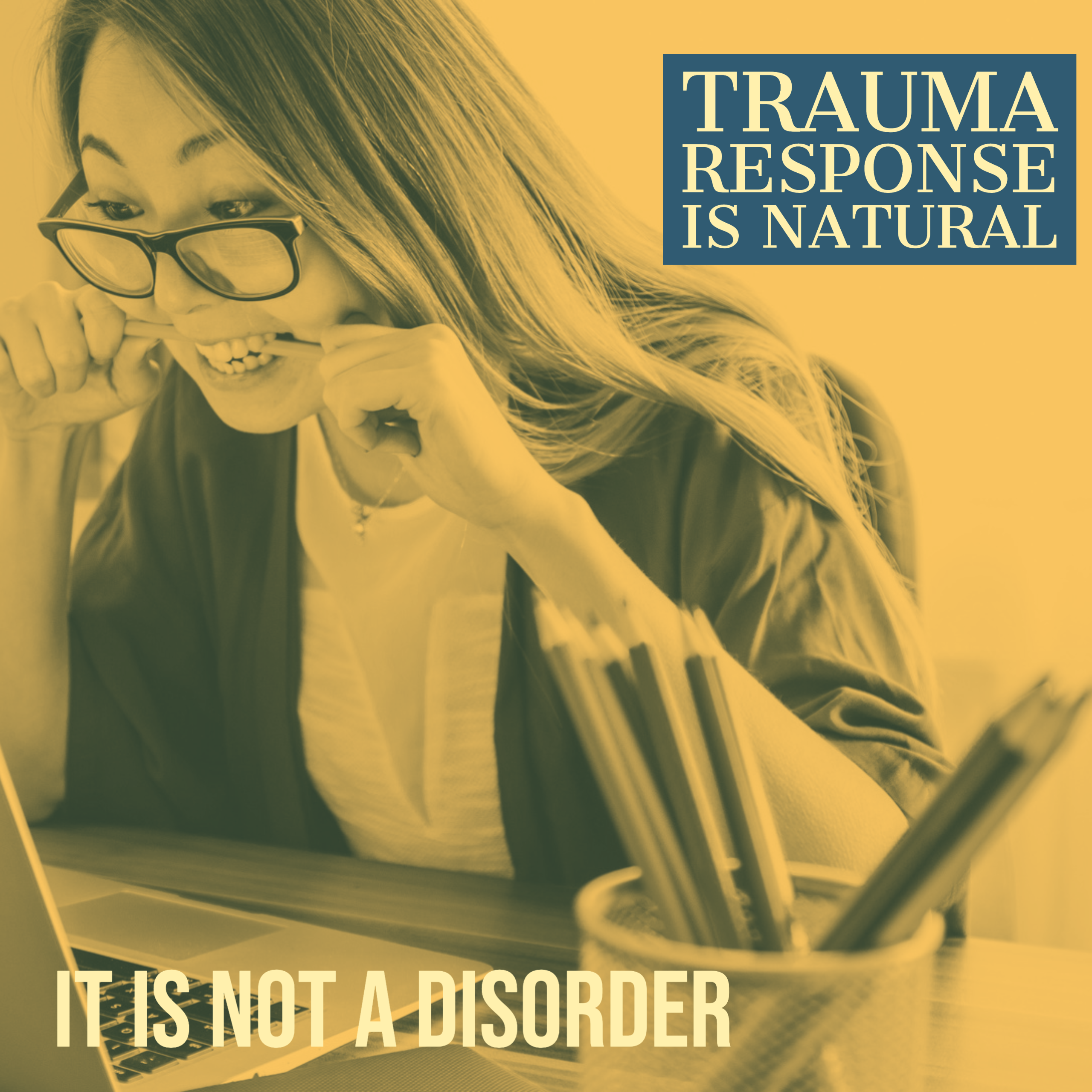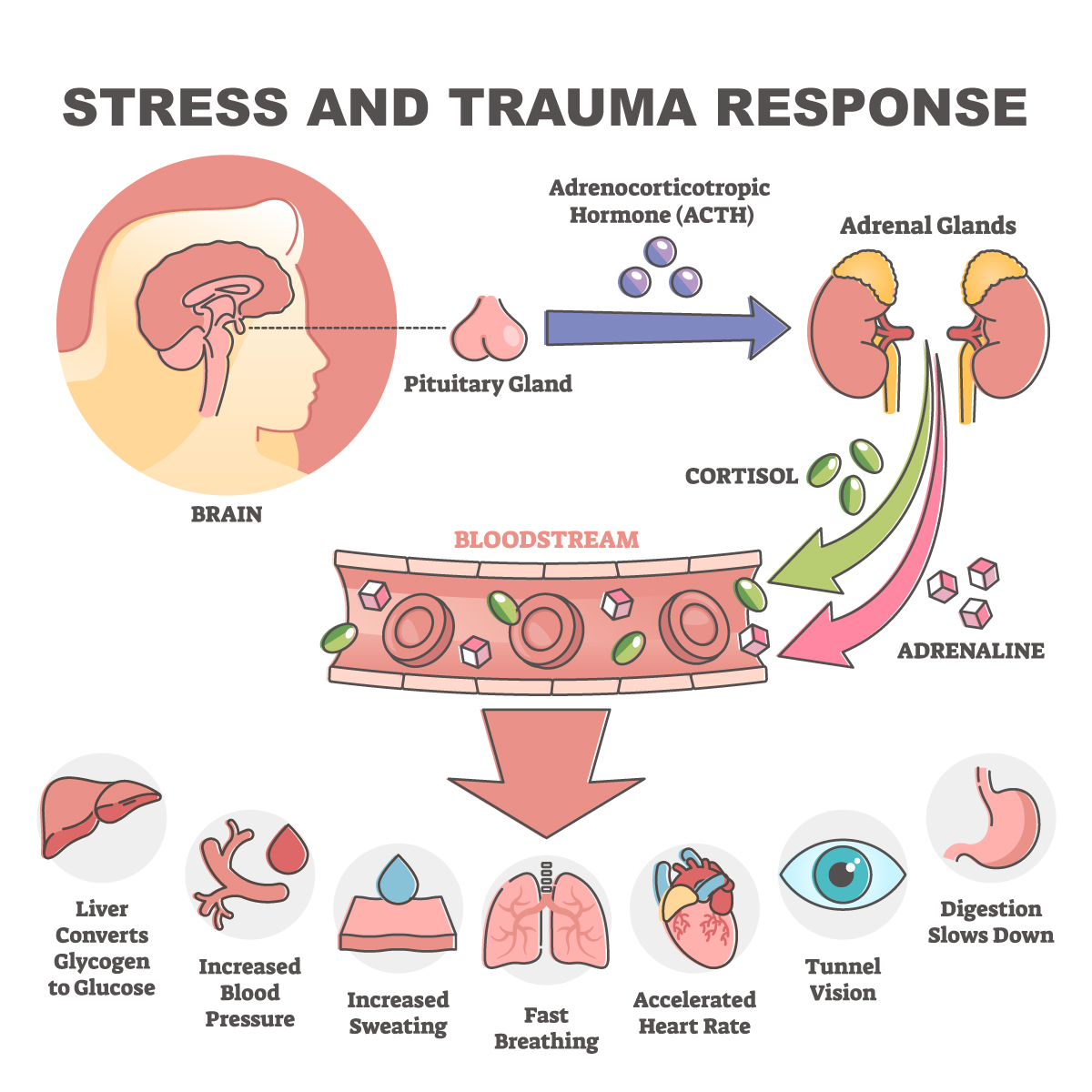Trauma Response Is Natural – Not a Disorder

Something’s not right. My stomach is doing flip flops. My heart is racing. My breathing is fast and shallow. Trying to sit still feels like torture. I need to run.
This is trauma?
I am experiencing the biological response to threatening stimulus also known as trauma response. It could mean the difference between life and death if I was being chased by a predator. But this was my typical response to making a presentation at work. So how is this helpful to me today? The quick answer: It’s not.
The longer answer is more complicated. Our body’s normal and natural response to sensed danger is efficient. Our trauma response evolved over eons to instinctually allow us to fight off or flee from predators. And lessor known, but equally important, is the freeze response where we instinctually determine it may be in our best interest to be still and unseen by “playing possum.” The freeze response was our last defense if we were not able to out-fight or out-run our adversary.
Our mind and body’s lightening-fast response not only allowed early man to survive in a dangerously wild world, it gave us just enough boost to thrive.
Primitive Survival Response in the Modern World
Fast forward to today. We’ve come a long way. Seldom, if ever, do we hunt or even grow our own food. Most of us have everything we need for survival: food, shelter, water, light, etc.
Compared to our ancestors, we lead relatively sedentary lives, where we must force ourselves to exercise. Our connection to nature is now a conscious choice.
Unless we are victim of a major tragedy – car accident, violent crime, natural disaster, etc. – our threats to our survival are nuanced, but our body still naturally reacts to all threats the same. If we do poorly at work, we may get fired endangering our access to food and shelter.
This threat to our survival, our pressure to perform, is now constant. The body’s natural quick survival response reacts more often. Since fighting or fleeing every time we face an obstacle at work would definitely get us fired, we are forced into freeze response.
Our life-saving release of adrenaline and cortisol is no longer released by taking immediate action. Even in the face of major tragedy’s like car accidents, violent crime and natural disasters, we take a more passive role while our amazing first-responders go into action.
Modern man has been programmed to alter their natural response to trauma.
We are trained to be stoic and calm in the face of adversity. We are taught from an early age that we must not give into our natural urge to fight or run away from foes. We are trained to keep a stiff upper lip and use logic to come to a resolution.
Don’t get me wrong, learning to remain calm and use logic are a good thing. But we have not been taught what to do with our natural responses in the mean time. The chemicals and energy released for fight or flight were ignored and allowed to build up in our bodies. Without release, our life-saving, instinctual response has festered into horrible health outcomes.
Holding onto Trauma CAN Cause Life-Threatening Diseases
The rush of adrenaline and cortisol along with energy along our neural pathways used to increase our heart rate and blood pressure to allow us to run faster and fight harder. Without release, it now leads to hypertention and heart disease.
The rush of adrenaline and cortisol temporarily suppressed our immune system and digestive system to divert valuable resources to our extremities. Without release, that now leads to life-threatening diseases, autoimmune disorders, and obesity.
The shallow breathing response we need for short-term physical performance has a long-term increase of anxiety, tension, and pain in our bodies.
The freeze response, if not released, causes numbing, memory loss, and disassociation from feeling our bodies and our emotions. This shows up in the form of mental health issues, addiction, and a higher potential to re-traumatization because we miss the important red flag alerts from our emotions.
Our body’s response to trauma – including the daily build-up of the small traumas we call stress – is normal and natural. It's our modern management (or mismanagement) of our trauma response that is the disorder.
Managing Our Response
While our bodies haven’t changed much over time, our lifestyles have. Now that we are aware of how our bodies respond to stress and trauma, it is important that we learn how to better manage our response and release it’s effects – and to teach our children to do the same at an early age.
One key strategy in combatting our trauma response is developing a mindfulness practice. Multiple studies show that practicing mindfulness – including meditation, yoga, deep breathing exercises, and more – builds resilience so that our bodies can handle more stress before it naturally reacts. It trains us to make conscious decisions earlier so that we are less likely to be taken off guard by danger and the subsequent stress response.
Another important strategy is learning how to release the effects of our trauma response once triggered. Yes, it is important to calm yourself out of a triggered state. This can be done with a few quick exercises (See my video on “5-4-3-2-1 See, Hear and Feel”).
However, it is also important discharge the stress and trauma stored in our bodies through somatic healing or what Peter A. Levine, author of the book Waking the Tiger: Healing Trauma, refers to as tapping into your “felt sense.” Tapping into your felt sense is a way of reintegrating your mind-body-spirit, thawing the freeze response, and releasing stored trauma. According to Peter Levine, an easy practice to begin the reintegration process is through the use of a water massage head in the shower for ten minutes or so a day. Using cool or luke-warm water, expose your full body to the pulsing water. He explains, “Put your full awareness into the region of your body where the rhythmical stimulation is focused feeling of the water is focused. Let your consciousness move over each part of your body as you rotate.”
As you shift your focus to each part of your body, Mr. Levine instructs, “Pay attention to each area, even if it feels blank, numb, or painful.” By accepting and identifying the feeling in each part of your body as your own, over time, you will re-establish a sense of your body – of being comfortable in your own skin.
Next Steps
Modern life is not going away. Few of us are willing to get rid of modern conveniences just to be more in sync with our primitive trauma response. However, we can develop healthy new habits that improve our resilience, come down faster when triggered, and maintain a beneficial integration of mind-body-spirit. We can create a culture where we don’t ignore or minimize the effects of stress and trauma, but take pride in leaning into

